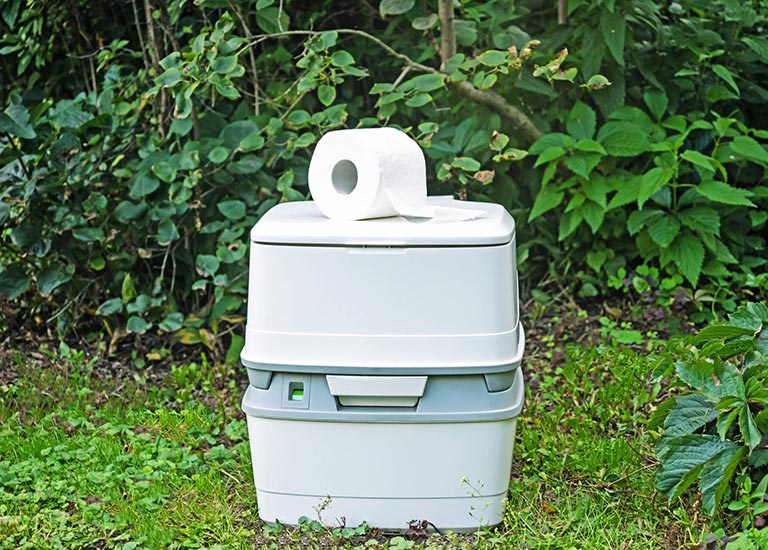What is a chemical toilet and how does it work?

When the term "camping toilet" comes up, many still think of a chemical toilet. And no wonder. After all, this quiet little toilet is still installed as standard in most motor homes.
In this article, we look at the "mother of all camping toilets" and take a close look at the mobile loo, from how it works to water consumption and the question of environmental friendliness. Of course, a comparison between chemical toilet and composting toilet may not be missing. ;) By the way, you can find out what the dry composting toilet is all about in our big composting toilet guide article.
How does a chemical toilet work?

A chemical toilet disposes of your waste using a combination of water, chemical additives and mechanical elements.
-
Seat and lid: A chemical toilet has a seat with a lid. You lift it, take a seat and do exactly what you would do on a conventional toilet ;).
-
Flush water tank: Under the seat is a flush water tank with clean water. With this, you rinse your leftovers into the waste water tank. To get water into the bowl, you operate a rinse water tank with a handle or a pump.
-
Waste water tank: Directly below the flushing water tank is the waste water tank, where the waste water including urine and solids is collected. To contain odors, this is usually closed with a lid.
-
Chemical additives: Special chemical additives are added to the wastewater tank in the form of liquids, tabs or powders. These additives have several functions. They decompose solids, neutralize unpleasant odors, reduce the germ load, and discolor the wastewater known as black water to brighten its appearance.
-
Aeration system: A fixed chemical toilet usually has an aeration system. By means of a blower or aeration shaft, the odor is removed from the toilet and adequate ventilation is provided.
Emptying the chemical toilet

When the wastewater tank is full, it must be properly emptied and cleaned. This job is done by special disposal stations at campsites. Disposal in nature must not take place under any circumstances! But more about chemical toilets and the environment later...
Chemical toilet and dry composting toilet: what are the differences?
Even if both toilets serve the same purpose, chemical toilets and composting toilets differ significantly from each other. Here is the duel of the two camping toilet candidates:
|
Dry composting toilet | ||
| Functionality |
|
|
|
| Odor |
|
|
|
| Toilet paper |
|
|
|
| Disposal |
|
|
|
| Cleaning |
|
|
|
| Usage |
|
|
|
| Accessories |
|
|
|
| Advantages |
|
|
|
| Disadvantages |
|
|
How much water does a chemical toilet use?
Motor homes have a water tank that holds a fixed volume. Therefore, water on the road is one of the limited resources. If you decide to use a chemical toilet, part of the fresh water is used for flushing large and small businesses.
The water consumption of a chemical toilet in a van or motor home depends on the size of the toilet, how often it is used and how often it is flushed.
A classic chemical toilet holds between 10 and 20 gallons of water. Exactly how much water is used per flush depends on the model. The average is 0.5 to 3 liters per flush.
Total water consumption depends heavily on usage. If the chemical toilet is used frequently or if you flush rather generously, you will use more water. If the chemical toilet is only used as an emergency toilet, the water consumption is lower.
Approximately how much fresh water do you use per day when camping

The daily fresh water consumption depends on your individual needs and the number of passengers.
The size of the fresh water tank varies from vehicle to vehicle. The volume of an average fresh water tank in a motor home is 40 to 150 liters, which is enough for several days, depending on consumption.
Daily consumption can be 10 to 20 liters per person, depending on your habits and the availability of showers and toilets. If your chemical toilet uses 1 liter of water per flush, you will lose 10 liters of the precious water when traveling with two people and using the toilet 5 times a day.
If you are at a campsite that has sanitary facilities with showers and toilets, your daily water consumption will be lowered because you usually use the sanitary facilities on site. In this case, you only need water for drinking, cooking and personal hygiene.
How environmentally friendly is the chemical toilet?
Chemical toilets are inexpensive to purchase, but the price is paid by the environment when chemical additives are used. The decomposition additives contain Microbicides, which are used to kill bacteria in the wastewater tank. If these get into the soil, sewage treatment plants or bodies of water, this has serious consequences. The substances can destroy entire microbial systems within ecosystems, causing significant environmental damage.
In addition, the chemical components in many chemical toilets often include aldehydes, surfactants and dyes. These substances irritate the respiratory tract, can cause allergic reactions, and can lead to chemical burns upon direct contact. This puts chemical toilets far behind in terms of environmental friendliness.





Leave a comment